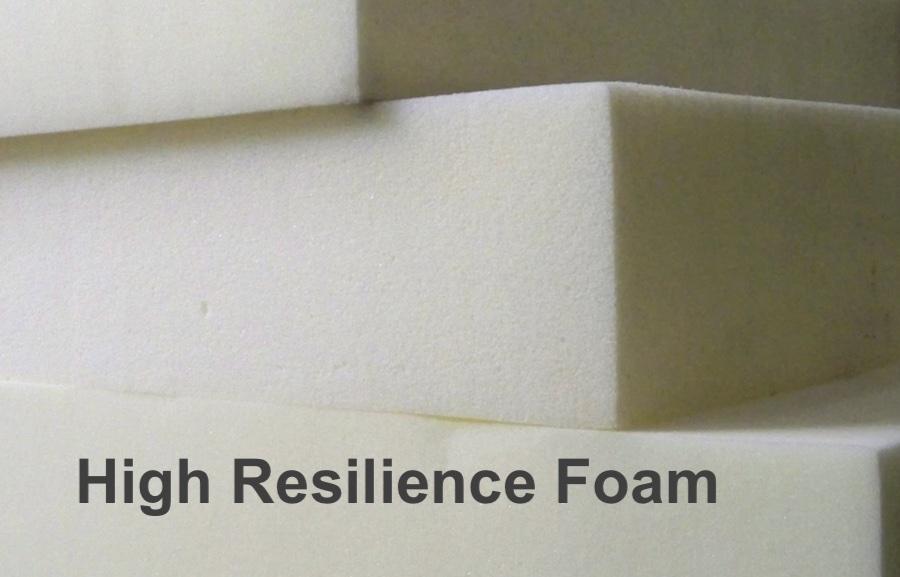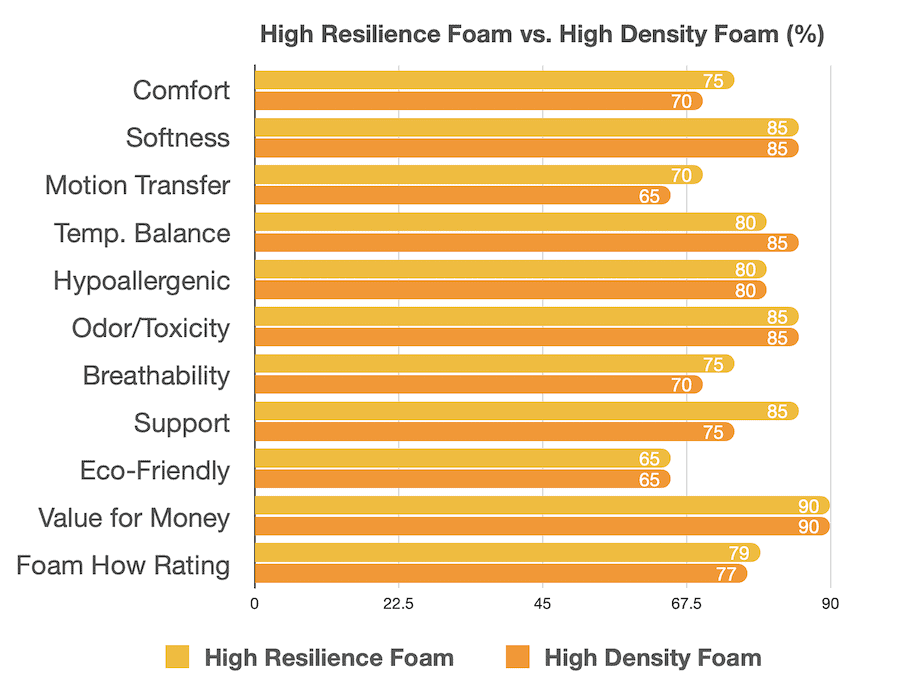You might not know it, but it’s likely that high resilience foam is in your home somewhere. But what is high resilience foam? Here I’ll go into details about what it is, its uses, and more.
High resilience foam or high resiliency (HR) is a high-grade open-cell foam of around 2.5 to 2.8 density. The cell structure has high elasticity and support. It maintains excellent bounce-back and load distribution features. Ideal for seats, sofas, and mattresses, and for heavy use furniture.
The bedding industry today is well equipped with a vast and varying range of mattresses, catering to thedifferent and specific needs of each individual customer.
To make your shopping experience easier, you’ll need to do some research beforehand on what exactly it is that you want in a good mattress.
Options such as memory foams, Latex foams, and high resilience foams are a few among many available options, each type has its pros and cons, and it’s up to the buyer to choose between them.
To make sure you’ve chosen what’s best for you, it’s essential that you get your research right. To help you decide, here’s some insight on the question of what is high resilient foam…
What is high resilience foam?
An open-cell, top-quality polyurethane foam, averagely weighing in at 2.5 lbs. per cubic foot is considered a high resilience foam.
As the name suggests, resiliency in such foams is much greater than in conventional mattresses. This means mattresses that contain some level of high-density foam are not only comfortable but also highly durable.
The cell-structure of HR foams enables the mattresses to be highly responsive and bounce back into shape, as well as offer appropriate support, and distribute pressure across a wide area, which can be beneficial in relieving pain.
The durability, flexibility, support, and comfort properties of a high resilience foam make it one of the most suitable and sought-after foams in the bedding industry.
This is where important factors come into play, namely density and firmness. Read more about density and firmness here.
High resilience foam is a polymer manufactured via a chemical reaction with, polyol, and diisocyanate. Other compounds and additives may also be mixed in to help provide elasticity and density too, but these two main organic compounds are mixed at a ratio of 2:1 to create polyurethane.
During the process, they are synthesized, poured into molds, and cooled before finally cutting into the required layers for use in mattresses.
How high resiliency foam is used in Bedding
Most mattresses are created using a layering effect with different foam and fabric materials. High resilience foam is often used in the middle layers of many popular memory foam brands, but higher or lower density varieties can be found in surface or base layers.
High resilience foam has a number of uses
The bedding industry, however, is not the only one that benefits from high resilient foams.
This type of foam is also popularly used by other furniture manufactures and in products apart from mattresses that are regularly and heavily used, such as couches.
This is due to HR’s high flexibility, excellent bounce-back property, overall ability to maintain its shape, and the durability to last for a longer time.

Compared to other foams
High resiliency foam is a mid-range polyurethane foam in many respects, It’s not to be confused directly with high-density foam which is more firm and often used at the base of mattresses and support around edging, but not soft enough to lie on the surface. HR foam has a better return-to-form than memory foam, but less “sink” which can be a benefit.
Here’s a chart providing an outline of polurethane foam compared to other main foam types.
| Foam Type | Latex | Memory | Polyurethane |
|---|---|---|---|
| Materials/Chemicals | |||
| Rubber tree sap | Yes | No | No |
| Formaldehyde | No | Yes | Yes |
| Petroleum derivatives | No | Yes | Yes |
| Flame retardant | No | Yes | Yes |
| Antioxident | Yes | No | No |
| Performance | |||
| Life span | <=20 years | <=10 years | <=10 years |
| Shape return | Instant | 1 Minute | Instant |
| Long term shape retention | Excellent | Fading | Good |
| Density (Ib per cubic feet) | |||
| Low density | < 4.3 | < 3 | < 1.5 |
| Medium density | Avg. 4.8 | Avg. 4 | Avg 1.6 |
| High Density | > 5.3 | > 5 | > 1.7 |
| Comfort | |||
| Temperature balance | Excellent | Poor/Medium | Poor/Medium |
| Relief of pressure | Very good | Excellent | Medium/Fair |
| Weight/body support | Excellent | Medium/Fair | Good |
| Motion Transfer | Medium/Fair | Low/minimal | Medium/Fair |
| Breathability | Good | Medium/Fair | Medium/Fair |
Pros of high resilience foam
High resilience foam has a number of benefits that fit very well with certain situations. I’ve outlined some benefits here…
Comfort
For customers that enjoy a firm and durable mattress, the high resilience foams are a good option.
The open cell structure of these foams, rather than closed-cell, allows the mattress to maintain a bouncy feel, and while it spreads and distributes weight very well, it doesn’t allow much motion transfer from one side of the mattress to the other.
The comfort element is aided by the support and weight distribution. The cells present in high resilient foams are tightly packed but are differently sized, this means that when the weight applied to is light, the smaller cells will react mimicking the reaction of soft foam.
When greater weight is applied to a high resilience foam, the larger cells present in it will come into play, ensuring that the weight is evenly distributed and appropriate support is provided.
Durability
High resilient foams are regularly used in furniture items that see heavy use. Particular in public spaces such as bus seating and benches in public buildings.
The reason behind this is that, due to its high flexibility and resilience, high resilience foams last much longer than conventional foams.
Cost
I add cost as a benefit because all mattresses cost money, but for the right circumstances, high resilience foam is a good investment.
High resilience foams tend to be higher on the cost side, which is why they are opted for by people looking for an item for the long term with high endurance.
The durability and ability of a high resilient mattress to maintain performance for up to 10 years or more is the main reason why customers think that products with this material are worth investing in.
Orthopedic benefits
High resilient mattresses are extremely comfortable but do they bring other benefits to the table apart from being comfortable and durable.
Due to their increased rate of flexibility, high resilience foams provide the user with appropriate weight distribution and support. For this reason, they can be used for certain orthopedic purposes.
Orthopedic in the bedding industry refers to mattresses that provide support for correct sleep posture, joints, and relief from pain.
Since high resilient foams provide optimal support, people with poor posture, back problems, and more can highly benefit from a high resilience mattress.
Maintains form and shape
Buying furniture isn’t easy and can prove to be quite costly, which is why when shopping, it’s essential that you buy something that won’t lose its shape or performance levels for a long time.
Furniture such as couches or mattresses that use high resilient foams is a great example of that. High resilience foams have high responsiveness and flexibility. This means that even after frequent and heavy use, you won’t end up with body imprints, broken springs, or flattened-out furniture for a good few years.
That’s not to say they won’t ever lose their shape, most (if not all) foams do. But you expect to get a good amount of years from HR foam before noticing any real change.
Density and firmness
Density and firmness are important attributes in any foam. In short, firmness is how “soft” the foam feels, whereas, density is how heavy the foam is and is an indication of quality and longevity. Read more about density and firmness here.

Cons of high resilience foam
High resilience foam does have its drawbacks, here’s where I list and go through some of them…
Cost
And yes I’ve also listed this as a benefit, because high resilient foams, while not extremely costly, and worth it for their endurance still do lie on the expensive side of the foam spectrum.
However, even though being slightly heavier on the pocket is a disadvantage, the foam really does show their worth for their price over time, which makes up for it by providing amazing comfort, support, and product longevity.
So if you’re confused or hesitant to buy a high resilient product, whether it’s a couch or a mattress solely based on the cost, the highlighted benefits should be kept in mind, and buying products with high resilience foam should be considered as an investment, as you won’t have to replace them anytime soon.
I always think of it in terms of the cost is incidental and will fade in time, but the benefits are what you will feel every day for years to come. If that stretches the fund initially then it’s worth it in the long run.
Offers give and bounce
High resilient mattresses can prove to be quite a nuisance for light sleepers, especially those with partners sleeping with them on the same bed.
The reason behind this is that since these foams have close cell structures, they can be more bouncy than say a memory foam mattress.
While for some, bounce is a bonus, until you become acclimatized to it, then it can cause disruptive sleeping patterns for others.
While weight distribution is good, it can also make the mattress prone to motion transfer and even though it’s not high, it is still present.
So if you’re a light sleeper and have a partner who moves often, high resilient foams might not be for you.
Off-gassing
The problem of off-gassing is common among foams that have polyurethane present in them
and high resilient foams that are made with a blend of polyurethane are no exception to this.
Off-gassing in mattresses refers to the breaking down of volatile organic compounds (VOCs). This break-down can cause the mattress to release unpleasant smells.
This is one of the biggest downfalls of high resilient foams and could be a concerning matter for those with an acute sense of smell, or those with ongoing lung problems.
While for most mattresses this off-gassing effect is strongest at the start and mostly temporary, it is something to consider.
High resilience foam Rating vs high density foam
Given all the pros and cons, this is how I measure high resilience foam vs high density foam…

To close…
So there you have it, I hope this has helped answer the question of what is high resilience foam. As well as provide an indication of how it compares with high-density foam.
Be sure to do your research when purchasing a mattress to ensure you get it right. If it contains high resiliency foam, then at least you know what contribution it brings with it.
